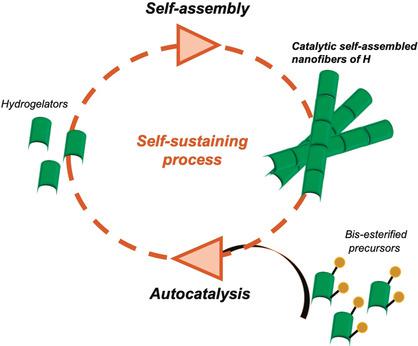当前位置:
X-MOL 学术
›
Angew. Chem. Int. Ed.
›
论文详情
Our official English website, www.x-mol.net, welcomes your
feedback! (Note: you will need to create a separate account there.)
Autonomous growth of spatially localized supramolecular hydrogel through emergence of autocatalytic ability.
Angewandte Chemie International Edition ( IF 16.1 ) Pub Date : 2020-05-28 , DOI: 10.1002/anie.202005377 Jennifer Rodon Fores 1 , Miryam Criado-Gonzalez 1, 2, 3 , Alain Chaumont 4 , Alain Carvalho 1 , Christian Blanck 1 , Marc Schmutz 1 , Fouzia Boulmedais 1 , Pierre Schaaf 1, 2, 3 , Loïc Jierry 1
Angewandte Chemie International Edition ( IF 16.1 ) Pub Date : 2020-05-28 , DOI: 10.1002/anie.202005377 Jennifer Rodon Fores 1 , Miryam Criado-Gonzalez 1, 2, 3 , Alain Chaumont 4 , Alain Carvalho 1 , Christian Blanck 1 , Marc Schmutz 1 , Fouzia Boulmedais 1 , Pierre Schaaf 1, 2, 3 , Loïc Jierry 1
Affiliation

|
Autocatalysis and self‐assembly are key processes in developmental biology and are involved in the emergence of life. In the last decade both of these features were extensively investigated by chemists with the final goal to design synthetic living systems. Herein, we describe the autonomous growth of a self‐assembled soft material, that is, a supramolecular hydrogel, able to sustain its own formation through an autocatalytic mechanism that is not based on any template effect and emerges from a peptide (hydrogelator) self‐assembly. A domino sequence of events starts from an enzymatically triggered peptide generation followed by self‐assembly into catalytic nanofibers that induce and amplify their production over time, resulting in a 3D hydrogel network. A cascade is initiated by traces (10−18 m ) of a trigger enzyme, which can be localized allowing for a spatial resolution of this autocatalytic buildup of hydrogel growth, an essential condition on the route towards further cell‐mimic designs.
中文翻译:

通过自身催化能力的出现,空间上超分子水凝胶的自主生长。
自催化和自组装是发育生物学的关键过程,并参与生命的出现。在过去的十年中,化学家对这两种功能进行了广泛研究,最终目的是设计合成生活系统。本文中,我们描述了自组装软材料即超分子水凝胶的自主生长,该材料能够通过自动催化机制维持其自身形成,该机制不基于任何模板效应,而是从肽(水凝胶化剂)自部件。事件的多米诺序列始于酶促触发的肽生成,然后自组装到催化纳米纤维中,随着时间的推移诱导和放大其产生,从而形成3D水凝胶网络。级联由迹线(10 -18 m)触发酶,它可以被本地化,以便在空间上分辨这种水凝胶生长的自催化结构,这是进一步进行细胞模拟设计的必不可少的条件。
更新日期:2020-05-28
中文翻译:

通过自身催化能力的出现,空间上超分子水凝胶的自主生长。
自催化和自组装是发育生物学的关键过程,并参与生命的出现。在过去的十年中,化学家对这两种功能进行了广泛研究,最终目的是设计合成生活系统。本文中,我们描述了自组装软材料即超分子水凝胶的自主生长,该材料能够通过自动催化机制维持其自身形成,该机制不基于任何模板效应,而是从肽(水凝胶化剂)自部件。事件的多米诺序列始于酶促触发的肽生成,然后自组装到催化纳米纤维中,随着时间的推移诱导和放大其产生,从而形成3D水凝胶网络。级联由迹线(10 -18 m)触发酶,它可以被本地化,以便在空间上分辨这种水凝胶生长的自催化结构,这是进一步进行细胞模拟设计的必不可少的条件。











































 京公网安备 11010802027423号
京公网安备 11010802027423号